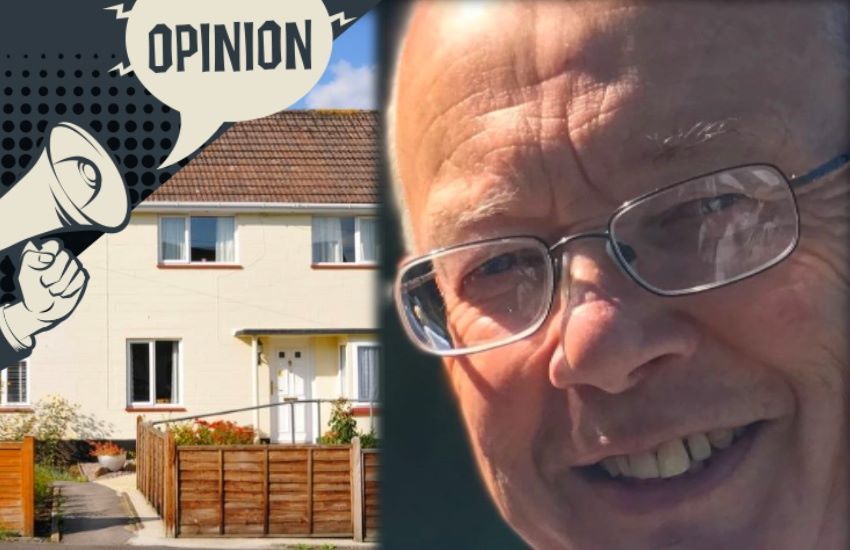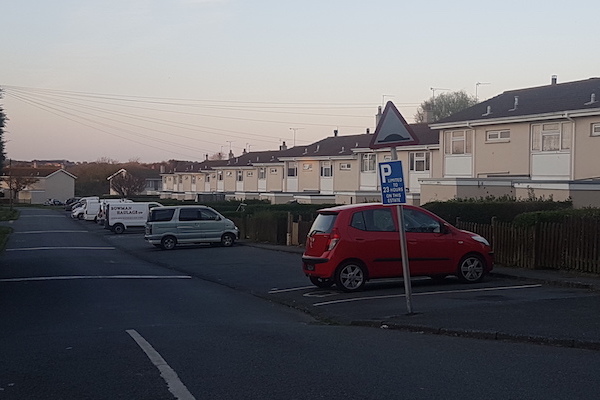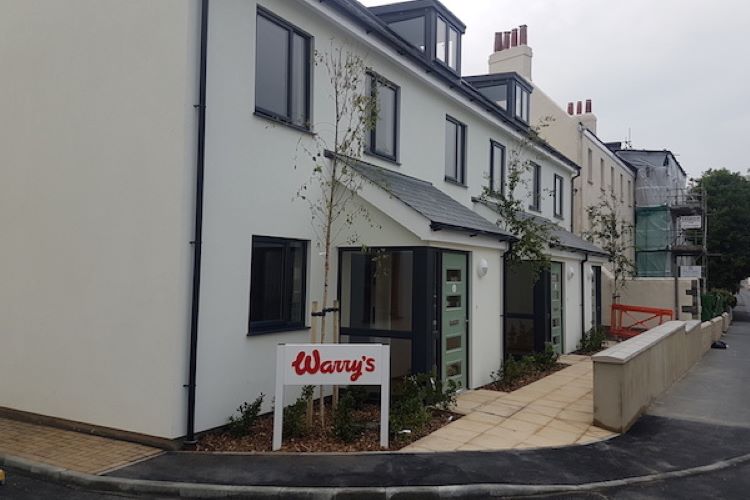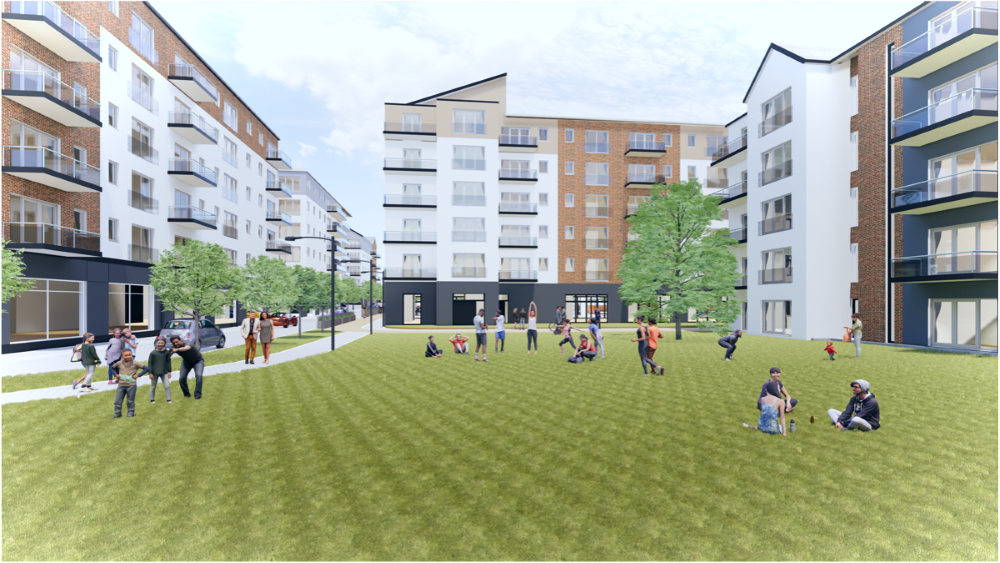


Andrew Le Lievre, one of the island's most experienced voices on social welfare and social housing, shares his thoughts about problems caused by previous housing developments and wonders whether some of those lessons are now being conveniently overlooked.
The chances are that during the course of your working day - whether taking the kids to school or going to work or the shops - you will pass many physical examples of solutions to previous housing crises.
From developments of four or five social housing units to much larger estates to the ubiquitous square dwellings of around 999 square feet with a window either side of a front entrance, a semi-circular arch and a pyramidical roof (topped off with two curly embellishments) of the ‘Homes for Workers’ age.
Most of these units of the latter type were built in the period 1930 to 1950. Many have now been extended or altered to some degree and changed hands for possibly as much as a thousand times their original build cost.

Pictured: Erecting greenhouses behind houses was a common practice when Guernsey's horticulture export industry was at its strongest in the middle of the 20th century.
For many thousands of islanders, these basic dwellings provided not only a sure footing on the housing ladder but in many instances a good income via a couple of hundred feet of glass developed on the relatively narrow plots at a time when ribbon development was all the rage.
During the course of your travels, examples of these easily discernible 'Homes for Workers' properties can be seen on the verges of just about any road – even in Torteval. Their clear design and almost total lack of differing features make them obvious – sometimes singly, at other times in pairs or threes. Together with the plot, they originally came at a cost of around £600, a price most of us nowadays would expect to cough up for a small dental procedure.
Over the years, commencing in the 1920s, the cost and quantum of loans might have increased but the most important facet of the 'Homes for Workers' loan scheme was that - from the outset almost right up to the end of its life in 2010 - it provided an affordable route to housing for families.

Pictured: Andrew Le Lievre is concerned that there are now fewer routes to affordable housing for young families without high earnings.
These units would be lived in for decades by the same family. They became family homes, not temporary waypoints. Real family units large enough to host Christmas get togethers involving several sides of the same family, albeit often without much room to spare.
At that time, of course, nobody had heard of affordable housing, housing densities, Rural and Urban Development Plans, Island Development Plans or Housing Associations. By the time these new terms became commonplace, many of these properties were already 70 to 80 years old.
There can be no argument that the very significant investment by the States to provide a subsidized loan scheme paid dividends over the decades by avoiding large upfront and ongoing expenditure on the approximately 4,000 additional units of social housing which would have been needed otherwise. That would have been 4,000 units on top of the existing 2,000 social housing units built during the last century.

Pictured: Andrew Le Lievre says the 'Homes for Workers' scheme was one of the reasons why thousands of people in Guernsey were able to build private homes when they would otherwise have required social housing.
The thrust of constructing small and medium-sized social housing estates coupled with subsidized loans for those able to build, buy ready-built or repair provided the answers to a range of various housing crises in the years 1920 to the mid-1960s. But this rather happy state of affairs was to change direction in 1968 with the publication of what became known as the Henchman Report after Deputy H C Henchman, the politician who led the group which produced it.
At that time, a significant reduction in the number of loans issued coupled with a downturn in the social housing build programme produced a housing crisis with very long waiting lists and a general and chronic shortage of homes for families. The reasons behind this crisis are as familiar to us today as they were then – a shortage of land and, therefore, the cost of building sites coupled with the prohibitive cost of building.
The Henchman Report’s answer, amongst other things, was to promote the building of what in Guernsey terms was a ‘super estate’ at the Grand Bouet using industrial, low-cost methods of construction on a relatively cramped site to create high-density housing for those on the lowest of incomes.
At the time of the build, the States were assured of the quality of the construction methods. But a huge question mark was raised a few short years later when tenants complained of being able to listen in on their neighbours' arguments and other more personal inter-relationships.

Pictured: Les Genats Estate, which was built in the 1970s when the island was experimenting with 'super estates'.
The Grand Bouet Estate was built in the early 1970s along with another 'super estate' - Les Genats at Cobo. Both developed unfortunate reputations, in particular the Grand Bouet Estate. Not very long after its construction, it had earned an unenviable reputation as a "sink estate more akin to a rundown inner-city estate in the UK". They are not my words, but rather the words of a highly-qualified and experienced social worker in the employ of the States back in the late 1980s.
The Grande Bouet Estate survived until the late 1990s when it was demolished. Nobody mourned its passing. It was built to a very limited budget and subsequently suffered lack of investment and maintenance, leaving it unattractive, unloved and largely unwanted. It has been completely redeveloped of course. Alas, the density of the accommodation provided now is not that different to that provided previously. The long-term effects of the rebuild won’t be known for perhaps another two or three decades.

Pictured: Social housing in the Bouet has been completely redeveloped in recent years.
It is on record that the States' committee currently responsible for social housing has far-reaching plans for improvements to Les Genats Estate to provide a better living experience for tenants. While the outcome of these changes cannot be predicted, it can be said with some certainty that Guernsey's overall experience of 'super estates' is not particularly happy.
We know that the development in the Bouet negatively impacted the lives of many children and young men and women. Broken homes, destroyed relationships and damaged children were a direct result of housing which was poorly planned, high in density and low in quality, the sole purpose of which was to crowd as many people as possible into a single development as cheaply as possible.
Thankfully, the Guernsey Housing Association does not have a reputation for acting as cynically as the States of previous decades did when developing 'super estates'. But I'm afraid that building high-density developments for tenants almost exclusively at or towards the lower end of the income scale will always raise issues of one form or another. In fact, lumping together lots of people with essentially the same socio-economic characteristics does not make much of a thriving community. Whether it's Les Genats or Fort George, albeit there is a greater sense of community at Les Genats.

Pictured: Andrew Le Lievre argues for keeping social housing developments small and thinks that larger developments have a greater range of unpredictable social outcomes.
I have concluded from experience that individual units coupled with small social housing estates is likely to be the most advantageous type of development in the long term whereas much larger and impersonal developments can provide quicker but temporary solutions and significantly introduce a greater range of unpredictable outcomes.
Given our painful and failed experiment with ‘super estates’, I am puzzled as to why there is apparently almost universal support for the latest proposed development at Leale’s Yard. It is nearly two-and-one-half times bigger than any previously constructed.
I am not suggesting that the proposed development is without advantages. I am not resigned to it causing all of the difficulties experienced with 'super estates'. But I am fearful that the lessons which should have been learned from earlier large developments not dissimilar from what is proposed at Leale's Yard are being conveniently cast aside in our desperation to increase the supply of housing.

Pictured: Current proposals for Leale's Yard include the largest single development of housing ever undertaken in Guernsey.
I think the best that can be said is that the social effects of a development of this size and character in Guernsey are uncertain. Instead of admitting that in an era where doubt is often seen as weakness, there is a rush to embrace the rather vague idea that the development will inevitably 'rejuvenate' The Bridge.
I admit I am biased. More than 30 years working at the sharp end of social welfare has left me with clear impressions about the undesirable outcomes associated with inadequate housing. But I would like to think I am also being realistic. And the bad experiences of other developments should remain in the memories of enough of us to question a little more vigorously the now widespread assurances that our housing crisis will be greatly alleviated by the proposals at Leale's Yard without creating the kind of social issues we were meant to be trying to leave behind.
Strong support for Leale's Yard plans from senior States' members
"Leale's Yard a real boost - but the States need to do a lot more"
Co-op plans "good for homes, good for business, good for community"
GHA hopes to add rental and specialist housing to Leale's Yard
Leale's Yard proposals receive mixed reviews from Bridge businesses
Latest plans out for Leale's Yard - with 300+ homes and a new Co-op
Parishes welcome Leale's Yard plans to help rejuvenate The Bridge
Comments
Comments on this story express the views of the commentator only, not Bailiwick Publishing. We are unable to guarantee the accuracy of any of those comments.